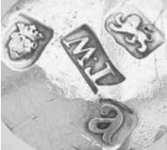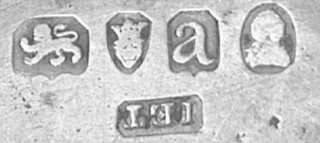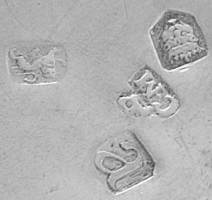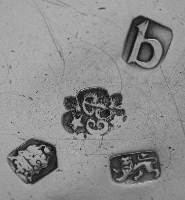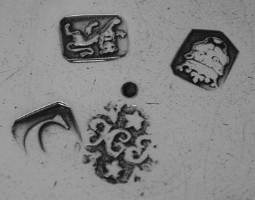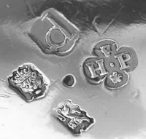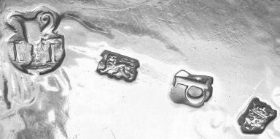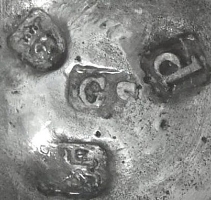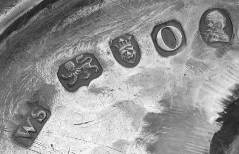by Giovanni
Ciceri
(click on photos to enlarge image)
BRITISH HALLMARKS - A CYCLE AT A TIME
I will propose in the next months some articles regarding
British hallmarks. Each article will be focused on a specific
cycle of British hallmarks, not taken in a chronological order,
beginning from the London Assay Office.
At the London Assay Office, each series refers to 20 years,
starting with the date letter "a" and ending with the date
letter "u" or "v". Only twenty letters of the alphabet have been
used, excluding: j, v (or u), w, x, y and z. Note that the last
letter of each cycle can be an "u" or a "v", but this is
probably due to the fact that in the classic Latin language and
alphabet there was no difference between "u" and "v". There is
only an exception in the 18th century, prior the introduction of
the Britannia standard (1696) (note
1 ), when the cycle lasted 19 years and ended with the
letter "t". Also the next cycle (from 1697 onward) lasted 19
years, but in this case all the 20 date letters have been used.
Each article will present real hallmarks stuck on wrought silver
plate of the current standard (sterling, 925/1000 and/or
Britannia, 958.4/1000).
Although the procedure followed from time to time on hallmarking
the silver objects is not the scope of these articles, I will
present and comment, for the same date letter, different
examples of actual hallmarks as found on various items.
Details on the British hallmarking system, including the meaning
of each hallmark struck on wrought plate are available at
http://www.argentinglesi.com/marchi-garanziaing.php
while facsimile of British hallmarks can be found at
http://www.silvercollection.it/englishsilverhallmarks.html
|
|
DETERMINING THE DATE ON LONDON ASSAY OFFICE MARKS
1776 - 1795 (XVI cycle)
This is the introductory page of the article about London
marks of 1776-1795 that will be published in the January 2011
newsletter. Its objective is to prevent mistakes in determining
the date marks of the period subject matter of our article.
Small roman letters have been used at the London Assay Office
for various cycles of hallmarks other than for the 1776 one:
between 1736 and 1755; between 1816 and 1835; between 1896 and
1915. To avoid misunderstanding and wrong attribution, consider
that inside some series were used punches of different shape to
contain the date letter. This happened in 1736, 1776 and 1896.
In the cycle 1618-1637 a mix of Italic and small roman letter was
used and this can result, in a few case, in possible wrong attribution.
Whereas it is very unlikely that a small collector can come into
contact with items of this age, we cite this fact for information
only.
When punches have similar shape (1776 and 1816 cycles) some
differences in the full set of hallmarks has to be taken into
account (note 4 ). In
particular, in the 1816 series the duty mark should be always
present, with some exception for small items exempted from duty
and (in a very few case as I can register) for detachable parts
of particular items like teapot, coffee pot etc. Furthermore,
after 1821 the leopard head is not longer crowned and the lion
passant is not longer guardant.
Main characteristic of cycles using the same small roman
date letters
|
1736 cycle
|
Thomas Wallis 1736/1737 (left)
Hugh Mills 1748/1749 (right)
The shape of the punches changed during this
series with and after date letter "d" (main
differences with 1776 cycle explained below)
|
|
1776 cycle
Richard Rugg II 1776/1777 (left)
(main differences with London 1736 cycle
explained below)
Hester Bateman 1787/1788 (right)
The cameo duty mark appears with and after
date letter "l"
|
|
1816 cycle
John Edward Terrey 1816/1817 (left)
- John Linnit 1827/1828 (right)
The duty mark should be always present in
this cycle (beginning from date letter "a" -
see the 1776 mark).
Beginning with the date letter "f" the
leopard head is not longer crowned (see
London 1787 mark).
The Duty mark (George IV profile) used from
1822 is slightly different from that used
before (George III profile)
|
|
1896 cycle
Horace Woodward & Co 1896/1897 (left)
- Samuel Watton Smith and Co 1908/1909
(right)
Punches are similar to those of the 1736
series after 1739 (see 1748 mark), but
different enough to avoid confusion.
The duty mark is not longer struck
|
|
The more common misunderstandings I experienced are between:
1) the date letters for the first four years of the 1736
cycle (note 5 ) and the
corresponding date letters for the 1776 cycle.
Although the punch containing the date letter is slightly
different for the two cycles, some problem can arise when the
hallmarks are partially rubbed. In case of doubt, is necessary
to look at the shape and the leopard head punch, which is
considerably different on the two series
|
London 1736/1737
Charles Martin 1736/1737 (left) -
William Abdy 1776/1777 (right)
Date letter for 1736 and 1776 are similar
but the punches enclosing the leopard head are
different. The 1736 mark has a punch with a
pointed shield, while the 1776 mark is enclosed
in a plain oblong punch. Furthermore, the punch
enclosing the lion passant for 1736 is a
rectangle with rounded corners while that for
1776 has a pointed base or, sometimes, is an
oval
|
|
London 1737/1738
Humphrey Payne 1737/1738 (left) -
John Schofield 1777/1778 (right)
Date letters for 1737 and 1777 are similar,
but the punches enclosing the leopard head are
different. The 1737 mark has a punch with a
pointed shield, while the 1777 mark is enclosed
in a plain oblong punch. Furthermore the punch
enclosing the lion passant for 1737 is a
rectangle with rounded corners while that for
1777 has a pointed base or, sometimes, is an
oval.
|
|
London 1738/1739
Humphrey Payne 1738/1739 (left) -
John Schofield 1778/1779 (right)
In this case the date letter for 1738 and
1778 are different. The "c" for 1738 has a
pointed top, while the "c" for 1778 has a round
top. Also the punches enclosing the leopard head
are different. The 1738 mark has a punch with a
pointed shield, while the 1778 mark is enclosed
in a plain oblong punch. Furthermore, the punch
enclosing the lion passant for 1738 is a
rectangle with rounded corners, while that for
1778 has a pointed base or, sometimes, is an
oval
|
|
London 1739/1740
|
Humphrey Payne 1739/1740 (top row, left)
Date letter punch first variant
John Tuitee 1739/1740 (top row, center)
Date letter punch second variant
Edward Bennett 1739/1740 (top row, right)
George Smith II 1779/1780 (bottom row, left)
Stephen Adams I II 1779/1780 (bottom row,
right)
The first variant of the date letter for 1739
and date letter for 1779 are similar, while the
punches enclosing the leopard head and the lion
passant are different. In case of "stressed
hallmarks" can be difficult to be distinguished
from each other
|
|
2) the date letter for 1789 and that for 1809.
Notwithstanding the date letter for 1809 is a capital Roman "O",
it is really very difficult to distinguish from the small "o"
for 1789. To determine the real date, consider that the small
1789 "o" has a round external shape and an oval internal shape
|
London 1789/1790
William Stroud 1789/1790 (left)
Thomas Johnson 1809/1810 (top right)
- William Eley, William Fearn and William
Chawner (bottom right)
The "o" for 1789 is round outside and oval
inside. The body of the letter has a different
thickness at the top and at the base than in the
middle part. The "O" for 1810 is slightly oval
outside and inside and there is no thickness
difference in the body. The other hallmarks are
very similar.
Note that in flatware hallmarks, since 1810, the
leopard head is struck at 90° with respect to
the other marks (see example on bottom right
image). In hallmarks struck in this way the date
letter "o" is certainly 1810 (while if the lion
passant is struck normally, the date letter "o"
may be either 1789/1790 or 1809/1810).
|
|
3) in case of partially rubbed hallmarks or in presence of "stressed"
hallmarks (note 6 ),
other evidences should be considered, like the year of
registration of the maker mark, the period of activity of the
maker or the style and shape of the item. Note that the date
letters "s" for 1793 and "u" for 1795 can be easily
distinguished from the capitals "S" for 1813 and "U" for 1815
|
London 1793/1794
John Wakelin & Robert Garrard 1793/1794
(left) - John Mewburn (possibly) 1813/1814 (right)
The only difference between the "s" for 1793
and the "S" for 1813 is the little slash cutting
at the middle the "s" for 1793. The other
hallmarks are very similar
|
|
London 1795/1796
Thomas Ollivant 1795/1796 (left)
- William Bateman I 1815/1816 (right)
The "u" for 1795 and the "U" for 1815 are
different enough to avoid confusion. The other
hallmarks are very similar, apart, occasionally,
the shape of the punch enclosing the duty mark
|
|
|
|
|
|
|
 ASSOCIATION OF SMALL COLLECTORS OF ANTIQUE SILVER
ASSOCIATION OF SMALL COLLECTORS OF ANTIQUE SILVER